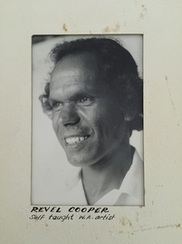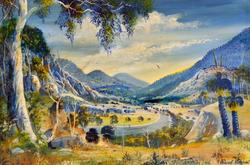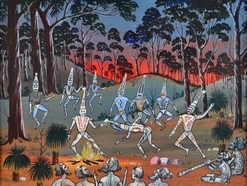Image may be NSFW.
Clik here to view.
Clik here to view.
Clik here to view.

"Firstly, the Aboriginal was deprived of everything, his country, the freedom to live his chosen way of life. But the greatest and most depressing loss of all was the loss of man's greatest and most treasured asset, the possession of pride. A man without pride is doomed to failure..." Revel Cooper, 1968
My apologies for the not uploading anything new on my Sharing Culture blog for a while, but I have been very busy on my two other projects. I thought I'd describe one of these projects in today's blog, as I have just launched the new project website - 'Revel' - that my colleague Michael Liu and I have developed.
The 'Revel' project involves the production of a feature length documentary about Aboriginal art, social justice, and the criminal justice system, as well as the search for family who have been fragmented for generations. The film will focus on Aboriginal artist Revel Cooper's life, and explore themes such as resilience, connection and cultural pride in the past, present and future.
Michael Liu will direct 'Revel' and we are supported by a strong core team, which includes Revel's niece Cathy Coomer. We are in the research phase of this project and are really excited. Here's a bio of Revel
Image may be NSFW.My apologies for the not uploading anything new on my Sharing Culture blog for a while, but I have been very busy on my two other projects. I thought I'd describe one of these projects in today's blog, as I have just launched the new project website - 'Revel' - that my colleague Michael Liu and I have developed.
The 'Revel' project involves the production of a feature length documentary about Aboriginal art, social justice, and the criminal justice system, as well as the search for family who have been fragmented for generations. The film will focus on Aboriginal artist Revel Cooper's life, and explore themes such as resilience, connection and cultural pride in the past, present and future.
Michael Liu will direct 'Revel' and we are supported by a strong core team, which includes Revel's niece Cathy Coomer. We are in the research phase of this project and are really excited. Here's a bio of Revel
Clik here to view.

Revel Cooper was one of the Aboriginal child artists from South West Australia who gained considerable recognition for their stunning art works in the late 1940s and early 1950s.
As a direct result of the government's assimilationist policies, these Aboriginal children had been taken from their families and often their country. They lived in harsh conditions on the Carrolup Native Settlement. They were encouraged to paint by their teachers Noel and Lily White and soon revealed remarkable talents.
Revel continued and flourished as an artist for the rest of his life. His work predates the beginning of the huge growth in Aboriginal art in the early 1980s. Many of his paintings 'speak' about Noongar land and culture. He has inspired at least two generations of Noongar artists.
Revel faced considerable adversity in his troubled life. In 1952, he was charged with murdering a Chinese man in Narrogin. After two trials in Western Australia's Supreme Court, he was convicted of manslaughter and sentenced to four years in the state's maximum security prison.
Revel stood little chance of a fair trial in Western Australia's racist criminal justice system. Many people believe that he did not commit the crime.
Being able to continue his painting in Fremantle prison, Revel passed on his techniques and style to other Aboriginal inmates. A number of the other Carrolup artists served time in Fremantle prison, an institution that may have helped create more artists than the local university.
Revel spent many years in and out of prison in Western Australia - where he was commissioned by Mary Durack to illustrate her book 'Yagan of the Bibbulmun' - and Victoria. He also suffered from a drinking problem, which did little to help him avoid spending time behind bars.
Revel befriended and was supported by many colourful characters, particularly whilst in Melbourne and Sydney, including Father Ted Kennedy, Bill and Lin Onus, Neil Counihan, James Davidson and the Harty family.
Revel stood up for Aboriginal peoples and their culture, and regularly spoke out about injustices in white-led Australian society. At the same time, he was well aware of the shortcomings of some of his people.
Revel's life ended tragically when he was murdered in 1983. He had been living in a car just before his death. His body was not found until 1985. He was eventually buried in 1987 in Victoria thousands of miles away from his homeland and family.
Today, Revel and his artworks remain a significant and continuing sign of resilience and hope for Aboriginal peoples.
As a direct result of the government's assimilationist policies, these Aboriginal children had been taken from their families and often their country. They lived in harsh conditions on the Carrolup Native Settlement. They were encouraged to paint by their teachers Noel and Lily White and soon revealed remarkable talents.
Revel continued and flourished as an artist for the rest of his life. His work predates the beginning of the huge growth in Aboriginal art in the early 1980s. Many of his paintings 'speak' about Noongar land and culture. He has inspired at least two generations of Noongar artists.
Revel faced considerable adversity in his troubled life. In 1952, he was charged with murdering a Chinese man in Narrogin. After two trials in Western Australia's Supreme Court, he was convicted of manslaughter and sentenced to four years in the state's maximum security prison.
Revel stood little chance of a fair trial in Western Australia's racist criminal justice system. Many people believe that he did not commit the crime.
Being able to continue his painting in Fremantle prison, Revel passed on his techniques and style to other Aboriginal inmates. A number of the other Carrolup artists served time in Fremantle prison, an institution that may have helped create more artists than the local university.
Revel spent many years in and out of prison in Western Australia - where he was commissioned by Mary Durack to illustrate her book 'Yagan of the Bibbulmun' - and Victoria. He also suffered from a drinking problem, which did little to help him avoid spending time behind bars.
Revel befriended and was supported by many colourful characters, particularly whilst in Melbourne and Sydney, including Father Ted Kennedy, Bill and Lin Onus, Neil Counihan, James Davidson and the Harty family.
Revel stood up for Aboriginal peoples and their culture, and regularly spoke out about injustices in white-led Australian society. At the same time, he was well aware of the shortcomings of some of his people.
Revel's life ended tragically when he was murdered in 1983. He had been living in a car just before his death. His body was not found until 1985. He was eventually buried in 1987 in Victoria thousands of miles away from his homeland and family.
Today, Revel and his artworks remain a significant and continuing sign of resilience and hope for Aboriginal peoples.
| Image may be NSFW. Clik here to view.  | Why not find out more about our project by checking out the website? We're meeting really interesting people, finding intriguing information, and experiencing all sorts of connections and coincidences. |